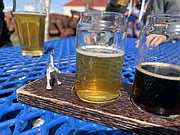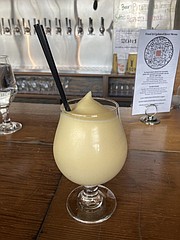Montana seltzers small, popular part of brewery market in state
POLSON — When Glacier Brewing Company came out with its Snowpack Limoncello Seltzer, more than a few craft beer drinkers took a liking to it.
“A lot of the regulars switched to this because it’s easy to drink but still drinks like a beer,” said Michael Wetherington on a recent day at the tap house. “You sip on it, and it’s not as light as White Claw.”
Montana drinkers have pushed the state to high per capita beer consumption — most recently No. 3 per capita after North Dakota and New Hampshire, according to USA Today citing data from beerinfo.com.
Two years ago, Food & Wine reported seltzers were “taking the world by storm,” and brewery staff in Montana report newer seltzers are creating another small but tasty corner of the market here, too.
“I think this ‘beyond beer’ category is gathering a lot of traction,” said Eric White, head brewer at Mountains Walking in Bozeman. “If it helps people get in the taproom, and after they have a seltzer, try something else, I think that’s really cool.”
Patrick May, tap house manager at Glacier Brewing, said seltzers make up for as much as 30% of the brewery’s production, a high number to which he attributes “a killer product.” He typically runs 10 to 12 beers, three to four seltzers, and four to five sodas at the brewery.
Generally, brewers make beer after yeast reacts with sugars in grain; they make seltzer by adding fruit to a base made after yeast reacts with sugar.
The limoncello is a flagship at Glacier Brewing, although its popularity is also due in part to May’s understanding of how to market a product. At first, the brewery set out to create a lemonade — which he said should be tart or sweet.
The beverage flopped, he said, at least as a lemonade.
“I couldn’t sell it,” May said. “It didn’t taste like lemonade. It wasn’t sweet. It wasn’t tart. And people’s heads couldn’t get around it.”
But he’s been in the restaurant, bar and grocery store industries a while, and he’d sold high-end limoncello in the past. The taste of the seltzer reminded him of the sweet lemon liqueur.
“I rebranded it, and within, like, a week, it moved up to be one of the three fastest-(selling) items, and it hasn’t slowed down,” he said. “It outsells other seltzers five to one.”
This year, it took home the “People’s Choice” award from the Bigfork Brewfest.
(Although some regulars made the switch from beer to seltzer in 2020 after the limoncello came out, some beer lovers also resist the fruity, lighter beverage. At the bar, Wetherington took a little guff from fellow regular Jason Wind for admitting he could drink a White Claw in maybe two gulps. Wind sticks with actual beer: “I’m a person who is anti-fruit in beer.”)
In Bozeman, White said Mountains Walking has spent a lot of time dialing in the base of the seltzers to make sure it’s clean and clear.
Now, compared to when the brewery first started creating seltzers, it’s dropped the alcohol content from 8% or more to around 5% or 5.5%, which White said is more approachable.
Seltzer accounts for less than 5% of the brewery’s production in a year, but it can spike as much as 10% a quarter depending on the period, he said. The brewery typically counts 20 to 25 beers on tap.
Mountains Walking has been making seltzers for more than two years, and he said the product is more stable than beer — maltose in beer reacts with oxygen, unlike sucrose in seltzer — so seltzer can have a longer shelf life if necessary.
White said he doesn’t expect seltzer to ever rival beer when it comes to production, but the newer drink allows people who don’t like beer — or can’t drink it — to enjoy a brewery experience too.
“Right now, for us, it seems like seltzer is really taking off,” White said.
In addition to the beverages, the brewery typically offers a beer and a seltzer slushy.
Mountains Walking created a New Hokkaido brand of seltzers featuring four flavors, pineapple, mango, lychee raspberry, and yuzu ginger, and White said customers have reacted well to the lineup of tropical, Asian-inspired offerings.
The beers have taken home several medals the last couple of months, but the seltzers are holding their own with customers.
“Our seltzer is very flavorful, interesting, and super crushable as well,” White said.
It’s difficult to track how much of the alcohol craft market is accounted for by seltzers. May said Montana was the top seltzer consumer per capita when White Claw first came on the market, and Money also reported the Treasure State being No. 1 in 2019.
However, White noted when the brewery reports to the Department of Revenue, it provides overall numbers, and it is not required to delineate seltzer production from beer. The Department of Revenue confirmed it does not require a breakdown.
The DOR’s Alcoholic Beverage Control Division requires label approval of brewery products that are more than 8.75% ABV. However, breweries only report total production, not a breakdown of product type.
“We know some of the breweries make seltzers, but we wouldn’t know how many breweries are doing that or how many seltzers versus beers they make,” the DOR said.
In Polson, May is expecting a busy tourist season this year, and visitors may help push up consumption of both beer and seltzer: “I’m expecting to get our asses kicked every day.”






